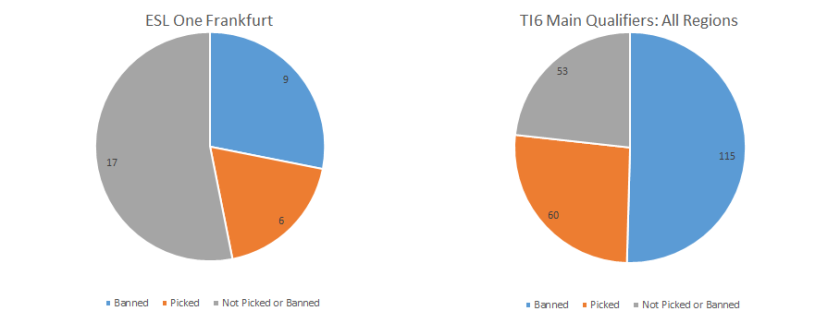Following on from version 6.87, arguably the most balanced patch since Dota was ported to the Source engine, Icefrog followed up with version 6.88. Notably, very little actually changed. There was the odd love tap here and there for some the heroes who proved popular at the Manila Major, but very little in the way of hero reworks or major balance changes. Consequently, the meta of the following tournaments, most notably ESL One Frankfurt and the TI Qualifiers can better be regarded as an evolution of the 6.87 meta, with various different hero picks but fewer major changes in play style, at least compared to previous balance patches. While there have been numerous shifts and trends in terms of picks, the one I’d like to write about today is the spike in Terrorblade picks.
From the hell of hells I come.
If you’ve been watching Dota for a while, you may remember the porting of Terrorblade, its borderline broken jungling speed in pubs and subsequent (ab)use in professional games by players such as EternaLEnVy, eventually leading to its gutting and fall out of the meta.
In 6.87, Terrorblade received a small but significant buff to the hero’s starting armour, bringing it up to 10 at level 1. Again in 6.87c, Terrorblade received another round of small but significant buffs, removing Metamorphosis’ Base attack time penalty and decreasing the amount of damage taken by illusions from Conjure Image; a small backtrack on the nerf to the spell in 6.82c. Despite this, Terrorblade received little play at Manila, with 3 picks and 3 bans for a total P/B rate of 5.9%.
In 6.88, Terrorblade received yet another round of buffs, seemingly smaller and less consequential than the last. Conjure Image’s mana cost was reduced by 10 and the illusion duration increased by 2 seconds, and yet in this patch, Terrorblade has emerged at the forefront of the meta. At ESL One Frankfurt, the first major tournament of 6.88, Terrorblade leapt to a P/B rate of 46.9% (18.8% Pick, 28.1% Ban) , still well behind other P/B leaders like Io (87.5%) and Pheonix (84.4%), but far more prominent than at Manila.
This brings us to the TI6 Main qualifiers, in which Terrorblade exploded in popularity. Across all four regions, Terrorblade boasted the 3rd highest P/B rate, at 76.8% (26.3% Pick, 50.5% Ban). Compared to ESL One Frankfurt, the rate rise is mostly accounted for by the increase in Ban rate, although the Pick rate increased substantially too.

P/B rate was consistent across all four regions, lowest (a tie) in North America and China at 75%, and highest (barely) in Southeast Asia (79%). It seems somewhat fitting that Southeast Asia, a region known for its superstar illusion carry players such as Meracle (Naga Siren) and LaKelz (Anti-Mage) also boasts the highest P/B rate for this illusion carry. Also of note is Europe’s high Pick rate and low Ban rate, for reasons explained later.

Winrates however, were far from standardised across regions. Continuing our narrative about carry players from SEA, Terrorblade had the highest win rate in the Southeast Asian qualifier.By contrast, Terrorblade had the lowest win rate in Europe, which goes some way towards explaining why Europe also displayed the least concern about leaving the hero unbanned and letting it be picked away. In both Europe and China, banning Terrorblade appeared to be a losing strategy, although even if we supposed teams were equally skilled in all areas of the game, this is still not a statistically improbable result.

On a final note, and somewhat inexplicable to me, Terrorblade’s frequency of appearance on Dire seems far higher than perhaps one might expect. While again, it is not strictly statistically improbable for such a result to occur (likelihood >5%), it still appears somewhat odd. Terrorblade does output massive physical damage, thus one might assume that picking the hero on Dire further leverages the natural advantage around Roshan. However, the damage is heavily illusion based and thus ineffective against Roshan. Professional teams and players, of course, would have greater insight into this than I would, and I hope that this is discussed on some panel in the lead up to TI.